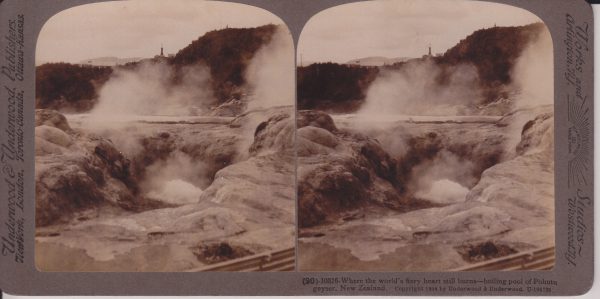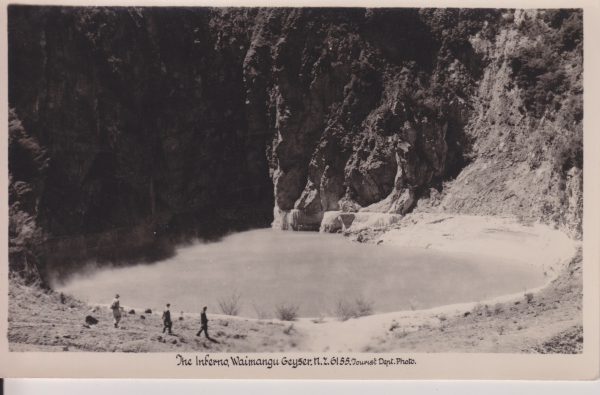The names and labels used are based on several maps and sources, some of which disagree.
Posted on
Notes and Observations on Geysers in Yellowstone and Elsewhere
The names and labels used are based on several maps and sources, some of which disagree.
Videos:
Observation reports:
Other, non-thermal videos:
Today we returned to the Whakarewarewa thermal area, but on the Maori village side. We got a late start because we misunderstood the types of tours offered. You can't see Korotiotio and Parekohoru on the Geothermal Walks self-guided tour, but need to take the Village Legacy Tour. But that also includes access to the Pohutu viewpoint, where we spent much of our time.
The view of the Geyser Flat, while not close, is still pretty good. You can see enough of Kereru to get an idea of what it is doing, and Mahanga is visible at the same time. We arrived there while Pohutu was active. It was probably early in the eruption of Pohutu, because it continued to erupt for half an hour. We saw the start of a Mahanga series which lasted about 12 minutes.
After 45 minutes or so, Te Tohu started, and almost immediately, we also got an eruption of Kereru. As in the other times we've see it erupt, it seemed to have been quiet before the eruption. Afterwards, it was having strong minors for the next hour or so.
Two hours later, an eruption of Pohutu had come and gone. There were three series of Mahanga eruptions, lasting from 9 to 14 minutes. Pohutu had been erupting for about 12 minutes, and it was three minutes short of two hours when we got to see a second Kereru eruption.
At that point, we took our Geothermal Walk. The area covered is large, with numerous hot pools with occasional mudpots and areas of what appear to be perpetual spouters. The underbrush is thick is many places, hiding features so much that you can hear them, but not see them.
Since we still had an hour before closing, we went back to the overlook, but were blocked out by some tours. By the time we got to the platform, it looked like Kereru was finishing an eruption. Over the next hour, it had many strong minors. Some of these would put up jets of water well above the higher Geyser Flat platform. If that was an eruption, then the interval was about 1-1/2 hour, which fits our previous experiences.
During that time watching the minors, we saw Mahanga end a series, then have another that was still going 19 minutes later, when we finally had to leave the area. At that time Pohutu was still about ten minutes away from another eruption.
Today it was off to Waiotapu. Most of the features were not much different from our visit four years ago. The biggest change was that there was now some runoff down the Primrose Terrace, especially the bottommost, narrow portion. The water in Devil's Bath/Roto Karikitea is the same industrial green as before.
The other difference is that the walkway past the Waitapu Geyser is closed off. That was a huge disappointment. But fortunately, the geyser is still visible, but from a high, distant vantage point. It is easy to pick out if you know where to look.
From what we could see, the area around the vent was dry. This is probably a good indication that we were there in the middle of the cycle. Late enough that the water from the previous eruption has evaporated, and early enough that the cycles of overflow had not yet started. We decided to not stick around.
We decided against going to see the induced eruption of Lady Knox Geyser. Instead, once the tours stopped around 09:45, we pretty much had the area to ourselves for over an hour.
Unlike the previous visit, there didn't seem to be a huge mass of people appearing after that eruption. The parking lot seemed mostly quiet as we had a picnic lunch, and I didn't see any bus tours during the afternoon. That may be normal, but it seemed that the closure during the middle of the week would be justified for a lack of visitation.
Next up was Waikite, a small area we missed last time. It's the home of Te Manaroa, a boiling cauldron discharging 40-50 liters per second. It's right next to a road, but down in a gully so that the steam collects there, making observations difficult. It continuously boils, occasionally surging to about two meters, although the amount of water being discharged doesn't seem to change.
Nearby is another, small boiling spring. Above it is the discharge from a third spring not visible from the walkway.
Note that there is a NZ$4 entry fee, but this feature is interesting enough to be worth it.
After that, we stopped in at Te Kopia. The mudpots are liquid, with little to no activity. They are also a pale blue color, as if they are in the process of clearing.
The walkway to the boardwalk appears to not have had any vegetation cut back since our last visit four years ago. The stairway was overgrown with wild berry vines with little stickers.
Our drive back from grocery shopping took us past the end of Fenton St. There is a parking lot there where the geysers of Te Puia are sort of visible through a fence when they erupt. We arrived at 17:15 with Te Tohu/Prince of Wales Feathers in eruption. We waited for about fifteen minutes as it erupted, then Pohutu started at 17:31 A few minutes later, at 17:40, we saw the tops of jets of water from Kereru. I would hope that that would be an indication that we will be able to see Kereru up close in the coming days.
Here are a series of stereoviews taken of New Zealand geysers taken around the start of the 20th Century.
This is a view of Kereru Geyser and the Geyser Flat mound where Pohutu Geyser is located. Kereru is the low, darker mound along the stream bank. When we visited in 2019, the area where the cooking is occurring was an area with numerous frying pans, but no distinct erupting features that I could see.
Now called Papakura Geyser, this feature was a large perpetual spouter upstream from Pohutu Geyser along Puarenga Stream at Whakarewarewa. The activity ended in 1979, and that cessation lead to the campaign to limit the use of geothermal bores within 1.5 kilometers of Pohutu. Papakura did erupt for a couple of days in 2015.
With the production wells for the Wairakei powerplants nearby, this feature is now a hole in the hillside filled with vegetation.

The large vent in the center seems to actually be the vent of Te Horu, which in years past would show sympathetic responses to Pohutu's activity. I believe Pohotu is actually the mound cut off by the right edge of the photo.
This feature is located near Pohutu, and has underground connections to it. It has been occasionally active the last few decades. When we visited in 2019, that was not one of those times, as it and nearby Mahanga were steaming and depositing sulfur around the vents.
This is probably near the overlook we hiked to when visiting in 2019. On the left side Fenton Street is visible. Fenton was laid out to point directly toward Waikite Geyser, which is located in the bare area behind the standing woman. Pohutu Geyser and the Geyser Flat is the bare area above and to the right of that. Off in the distance, Sulphur Bay of Rotorua Lake is visible. The Whakarewarewa village is in the steaming area to the left of the center of the view. Note that today, the whole area beyond the thermal areas is the city of Rotorua. Much of the hillside to the right is now covered in trees.
Today was going to be the start of nine days of visiting the thermal areas in and around Rotorua. That didn't happen, but here are a few old postcard views showing things that, for the most part, we wouldn't have seen anyhow.
This feature, on the west bank of the Waikato River, now lives beneath the waters of Lake Ohakuri to the north of the ferry crossing over to the terraces. In the 1940s it erupted as frequently as every three hours to heights up to 24 meters (75ft).
This card has a postmark from 1905, so it is quite possible that it is showing activity from Waimangu.
A view copyrighted 1902.

This feature is located about 50 meters to the northeast of where Waimangu was located. It currently has an approximate 38 day cycle of rising to overflow for a few days, then falling. It is also now surrounded by much thicker vegetation.
This geyser has not been active in decades, but has at least shown signs of recovery since the shutdown of hot water wells in the area.
One of the features to the right is most likely Pohutu. There are several other features nearby, including Te Horu and Mahanga.
From left to right, it looks like these are Kereru, Mahanga, Pohutu and Wairoa. The view is from the opposite direction of the preceding views, and now what one would first see upon entering through the gate. As with Inferno Crater, there is now a lot more vegetation in the area on the left.
All of the dozens of geysers in the Geyser Valley at Wairakei were destroyed when the power plants started back in the 1950s and 1960s.
* The name translates to "The urine from [Chief] Homai-te-rangi" [Lloyd, Geology and Hot Springs of Orakeikorako, NZ Bulletin #85, pg.59]. We need more names like this in Yellowstone.